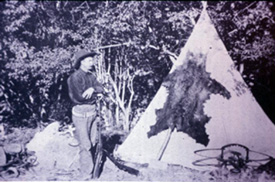Lectures
Carolyn lectures at museums, clubs, and universities across the country. Often invited to be a repeat speaker, one audience enjoyed her talk so much, they have asked her back 2 more times — to give the same presentation. To make arrangements for a presentation, contact Carolyn at cobagy@aol.com.
Carolyn O'Bagy Davis
PO Box 85787, Tucson, AZ 85754
cobagy@aol.com

Carolyn at Pueblo Bonito, Chaco Canyon
Nora Lucy Mowbray Cundell:
An English Artist at the Vermillion Cliffs
English artist Nora Cundell (1889-1948), along with her sister Violet and brother-in-law Charles Eaton, traveled to Arizona to see the Grand Canyon in 1934. Nora had read descriptions of the canyon and northern Arizona written by her friend J. B. Priestley, the English author and playwright. Priestley and his family made several visits to the Grand Canyon, the Vermillion Cliffs, Painted Desert, and Navajo country. His writings intrigued Nora enough to plan a trip to America to see those places for herself.
Upcoming Exhibition:
April 11-13, 2019 - Arizona History Convention, Prescott, Arizona

Nora Cundell, left, and Christina Klohr, right, 1947, Lee's Ferry. Courtesy of Bernice Klohr.
Goldie Tracy Richmond: Indian Trader, Trapper, and Quiltmaker

Goldie Tracy Richmond & Prospecter Quilt
Arizona's Historic Trading Posts

John and Sue Bradley, Warren Trading Post c. 1930, Kayenta, Arizona.
Hopi Quilting: Stitched Traditions from an Ancient Community

Frieda Yoyhoeoma
Hopi Summer

Walpi First Mesa
Kayenta and Monument Valley:
100 Years of Settlement and Trading in Navajo Indian Country

Kayenta Trading Post
The Fourth Wife: Polygamy, Love, & Revolution

Julia's Family, 1934
Nat Straw and the Gila Wilderness

Nat Straw
Burt and Hattie Cosgrove and the Mimbres Archaeology of the American Southwest

Hattie Cosgrove
